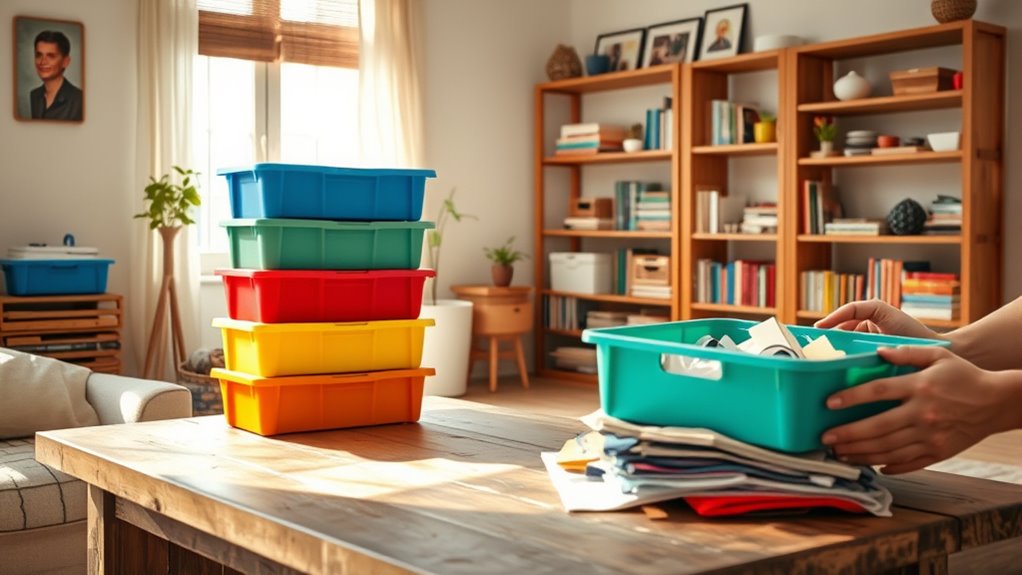To start decluttering your home, first assess your space and set clear, achievable goals for what you want to accomplish. Gather supplies like boxes, labels, and storage containers, then break your home into manageable sections. Sort your items into keep, donate, recycle, and discard piles, creating an organized system for what stays. Focus on one area at a time and establish a routine to keep progress steady. Keep going, and you’ll discover more tips to maintain your organized space.
Key Takeaways
- Assess your space and set clear, achievable decluttering goals to guide the process effectively.
- Gather necessary supplies like boxes, labels, and storage containers before starting.
- Divide your home into manageable zones and prioritize high-traffic areas for quick wins.
- Use categorization and labeling to organize similar items and create designated storage spaces.
- Maintain progress with regular, scheduled sessions and celebrate small milestones to stay motivated.
Assess Your Space and Set Clear Goals

Before you begin decluttering, it is vital to evaluate your space and define what you want to achieve. Start by measuring your space to understand its layout and limitations—this helps you plan effectively. Clear goal setting keeps you focused, whether you want to create more storage, reduce clutter, or make your home more functional. Visualize the end result and write down specific objectives. Consider which areas need the most attention and set realistic targets for each. Knowing your space measurement allows you to determine what fits and what doesn’t, preventing overstuffing. Additionally, understanding the importance of attention in creative practice can motivate you to create a healthier living environment by incorporating proper ventilation and air purification strategies. By establishing clear goals from the start, you’ll stay motivated, organized, and efficient throughout the decluttering process.
Gather Your Decluttering Supplies

Before you start decluttering, gather the right supplies, like trash bags, boxes, and labels. Choose storage containers that fit your space and keep items organized, making cleanup easier. Also, decide how you’ll handle disposal or donation to guarantee everything finds a good new home. Using appropriate organizing tools can further streamline the process and prevent clutter from accumulating again. Incorporating mindfulness techniques during your decluttering can help you stay focused and reduce stress throughout the process. Additionally, grocery savings strategies can help you allocate resources efficiently for your decluttering project. Being aware of payment security measures can ensure that any online transactions related to donations or supplies remain safe and protected.
Essential Tools Needed
To start decluttering effectively, you need a few essential tools to make the process smoother and more efficient. First, gather your cleaning supplies like disinfectant, microfiber cloths, and trash bags. These help you quickly tidy up as you go. Digital tools, such as decluttering apps or checklists, keep you organized and motivated. Having a sturdy trash bag or recycling bin nearby is also key for quick disposal. Consider using a label maker or markers to identify items for donation or sale later. Additionally, understanding color accuracy and contrast ratios can help you better evaluate and organize your entertainment systems for a clutter-free space. Incorporating sound therapy techniques can also promote a calm mindset during your decluttering process. Being mindful of wall organization solutions can help you optimize space and reduce visual clutter throughout your home. Utilizing storage solutions like baskets and bins can further simplify organizing your belongings and maintaining order. Here’s a quick overview:
| Tool Type | Purpose | Examples |
|---|---|---|
| Cleaning supplies | Clean and prep surfaces | Disinfectant, cloths |
| Digital tools | Organize and plan | Apps, checklists |
| Disposal tools | Manage waste and donations | Trash bags, bins |
Storage Containers Selection
Choosing the right storage containers is essential for effective decluttering because they help organize your belongings and maximize space. When selecting containers, consider various container sizes to accommodate different items efficiently. Opt for clear containers to easily identify contents, and establish a consistent labeling system for quick retrieval. Incorporating variety of materials available can also ensure you select options that suit your specific needs and preferences. Additionally, selecting containers with secure lids can prevent spills and keep items protected from dust and pests. To enhance your organization, consider durability and stackability, which can optimize storage efficiency over time.
Disposal and Donation Options
Gathering your decluttering supplies is the first step toward making disposal and donation straightforward. Start by collecting sturdy boxes, bags, and labels to organize items you plan to discard or donate. For items that can be recycled, locate nearby recycling centers to guarantee proper disposal. When it comes to donations, identify local charities or thrift stores that accept furniture, clothing, and household goods. Keep donation receipts for tax purposes. Consider setting aside designated bins for recyclables and donations, making the process efficient. Before you start, check charity guidelines for acceptable items. Additionally, verifying the trustworthiness of donation organizations can ensure your contributions go to reputable charities. This preparation helps you stay organized, reduces clutter, and assures that unwanted items are responsibly recycled or donated to those in need. Incorporating sustainable disposal methods and understanding home furnishings can further enhance your decluttering efforts, ensuring environmentally friendly practices are followed. Being aware of recycling regulations in your area can also help you dispose of items more responsibly.
Break Down the Process Into Manageable Sections

Breaking down the decluttering process into manageable sections makes the task less overwhelming and more achievable. Adopting an organizational mindset helps you stay focused and motivated. To manage emotional attachment and avoid feeling overwhelmed, divide your home into specific zones or rooms. Here’s how to approach it:
Breaking decluttering into sections keeps it manageable and motivating. Focus on one zone at a time to stay on track.
- Prioritize high-traffic areas first to build momentum.
- Break large spaces into smaller sections, like drawers or shelves.
- Set clear goals for each session to stay focused.
- Schedule regular, timed sessions to prevent burnout.
- Incorporate automation techniques to streamline your decluttering process and maintain consistency. Recognizing the importance of functional layouts can help tailor your approach and make the process more effective. Additionally, understanding that symbolism in dreams often carries deeper meanings can inspire you to interpret your personal motivations behind clutter, making the process more meaningful.
This approach keeps you grounded, allowing you to address emotional attachment gradually while making steady progress. By tackling one manageable section at a time, you foster a sense of accomplishment and create a clearer path toward a clutter-free home.
Sort Items Into Keep, Donate, Recycle, and Discard
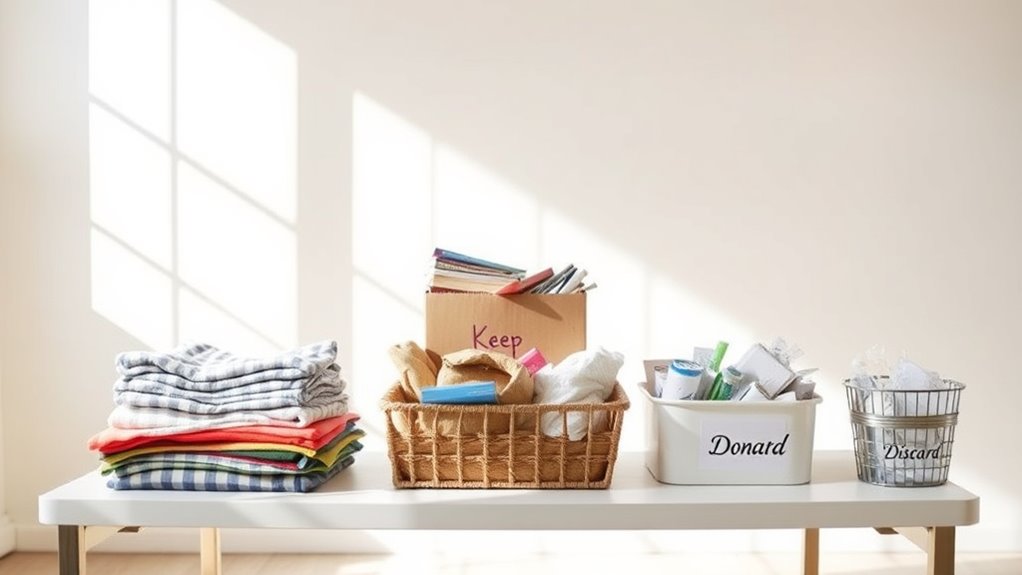
Once you’ve divided your space into manageable sections, the next step is to sort your items into four categories: keep, donate, recycle, and discard. As you go through each item, ask yourself if it contributes to your digital minimalism and if you truly need it. Be mindful of emotional attachment; sentimental items can be hardest to let go of, but consider if they genuinely serve a purpose now. Items with no future use should be recycled or discarded responsibly. Keep only those possessions that add value or joy to your life. Sorting with a clear mindset helps prevent overwhelm and keeps you focused on your decluttering goals. The process clears physical and mental clutter, making space for what truly matters, and practicing mindful decluttering can foster more sustainable habits. Additionally, understanding tiny house principles can inspire efficient use of space and reduce clutter in your living environment. Embracing space-saving strategies can further enhance your decluttering efforts, helping you create a more organized and serene home. Incorporating recycling programs can also ensure that items are disposed of in environmentally friendly ways, aligning with sustainable living goals.
Create a System for Organizing Kept Items
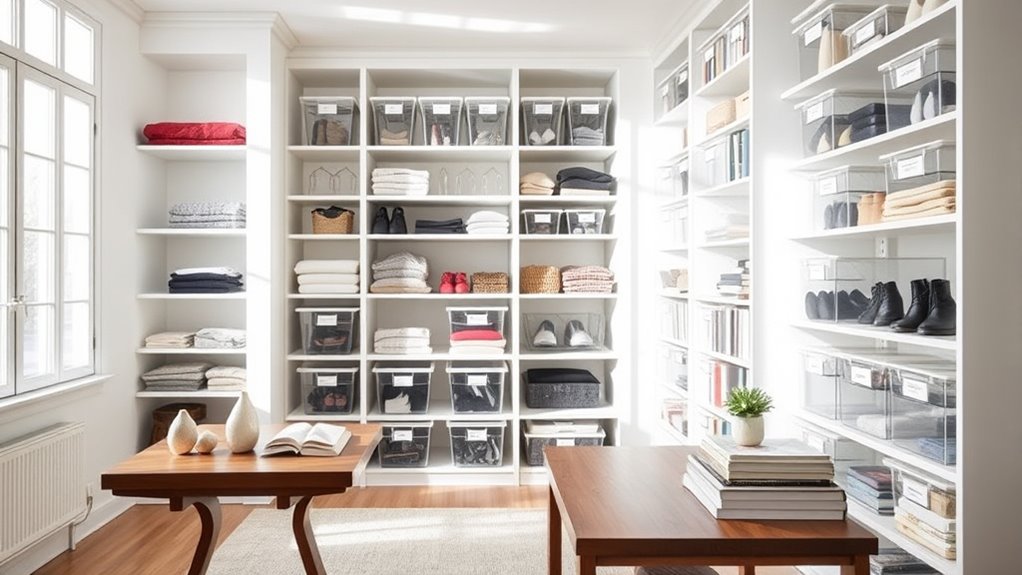
To keep your home organized, you need a clear system for your kept items. Start by categorizing similar items together and using labeled containers or shelves. Then, establish routine checks to guarantee everything stays in its designated spot. Incorporating ideas from water parks, such as creating designated zones for different types of belongings, can help streamline organization. Additionally, applying principles of effective organization, like maintaining consistent placement for items, can further enhance your system.
Categorize Items Effectively
Creating an effective system for organizing your kept items makes it easier to find what you need and maintain a clutter-free space. To do this, categorize items thoughtfully, considering their use and frequency. Use storage solutions that suit each category, such as bins for seasonal items or drawers for daily essentials. Implement label strategies that clearly identify contents, saving time and reducing frustration. Here are four steps to help you categorize effectively:
- Group similar items together based on their function or type.
- Assign specific storage solutions tailored to each category.
- Label each container or section clearly for quick identification.
- Review and adjust categories periodically to keep your system flexible and efficient.
This approach streamlines your space, making decluttering manageable and maintaining order effortless.
Maintain Consistent Routines
Maintaining a consistent routine is essential for keeping your organized system effective over time. Incorporate morning routines to start your day with a quick tidy-up, putting items back in their designated spots. This sets a pattern that prevents clutter from building up. Similarly, evening routines help you wind down and reset, ensuring everything is in its place before you go to bed. Dedicate a few minutes each night to organize and review your space, reinforcing your system. By sticking to these routines daily, you create habits that support long-term decluttering success. Consistency is key—over time, these habits become second nature, making it easier to maintain an organized home without feeling overwhelmed.
Tackle One Area at a Time to Stay Focused
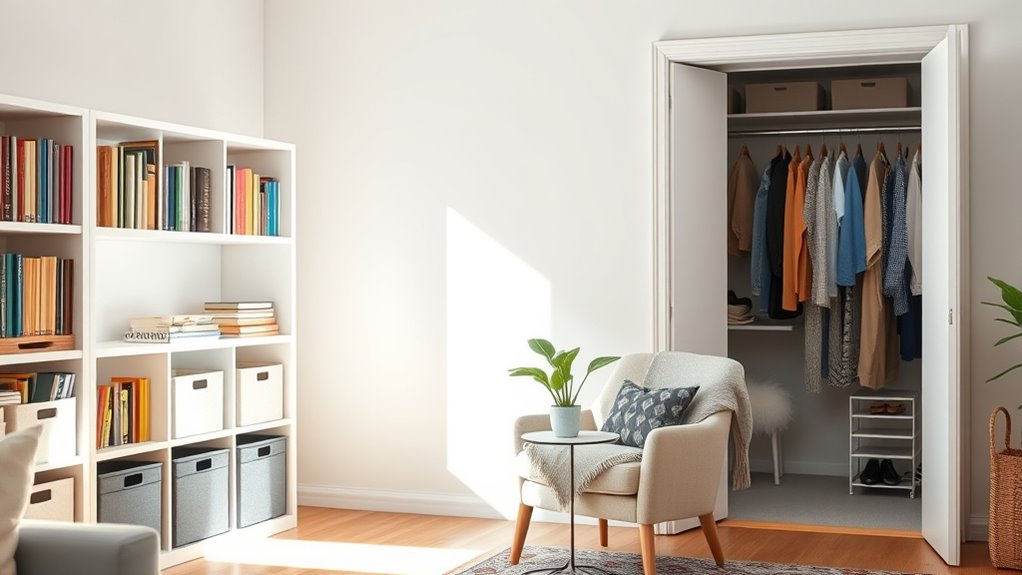
Focusing on one area at a time makes decluttering more manageable and less overwhelming. It allows you to practice mindful decision making and manage emotional attachment to belongings. To stay focused, consider these steps:
- Choose a small, contained space like a drawer or shelf to start.
- Set a timer to limit your decluttering sessions and maintain momentum.
- Prioritize items based on necessity and emotional significance.
- Resist the urge to multitask, so you give each area your full attention.
Maintain Momentum With Regular Decluttering Sessions
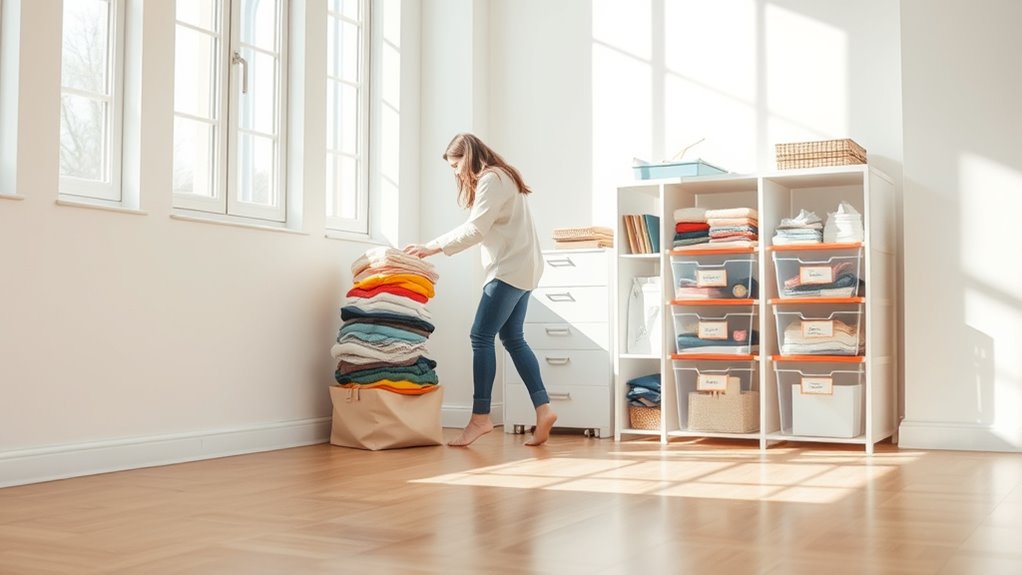
Once you’ve tackled a small area and gained momentum, keeping up the habit requires regular decluttering sessions. To stay motivated, develop simple motivational strategies, like rewarding yourself after each session or visualizing your clutter-free space. Consistent scheduling is key—use effective time management to set aside dedicated time, whether weekly or biweekly, so decluttering becomes a routine. Keep sessions manageable by breaking larger areas into smaller tasks, preventing burnout. Remember, progress builds motivation, so focus on small wins to stay inspired. By establishing a regular decluttering rhythm, you’ll maintain momentum and gradually transform your home into a calm, organized space. Staying disciplined with your schedule and motivation ensures decluttering becomes an ongoing habit rather than a one-time effort.
Celebrate Your Progress and Adjust Goals as Needed

Celebrating your progress keeps you motivated and reinforces positive habits. Recognizing small wins boosts your confidence and helps you stay committed to decluttering. Use progress tracking to see how far you’ve come, which makes goal adjustment easier. When your efforts lead to noticeable changes, take time to celebrate—whether with a treat or a moment of reflection. Consider these steps:
- Review your completed tasks regularly to measure progress.
- Adjust your goals based on what you’ve accomplished and any new insights.
- Set achievable milestones to stay focused and motivated.
- Keep a record of your successes to visualize long-term progress.
Develop Long-Term Habits to Keep Your Home Organized
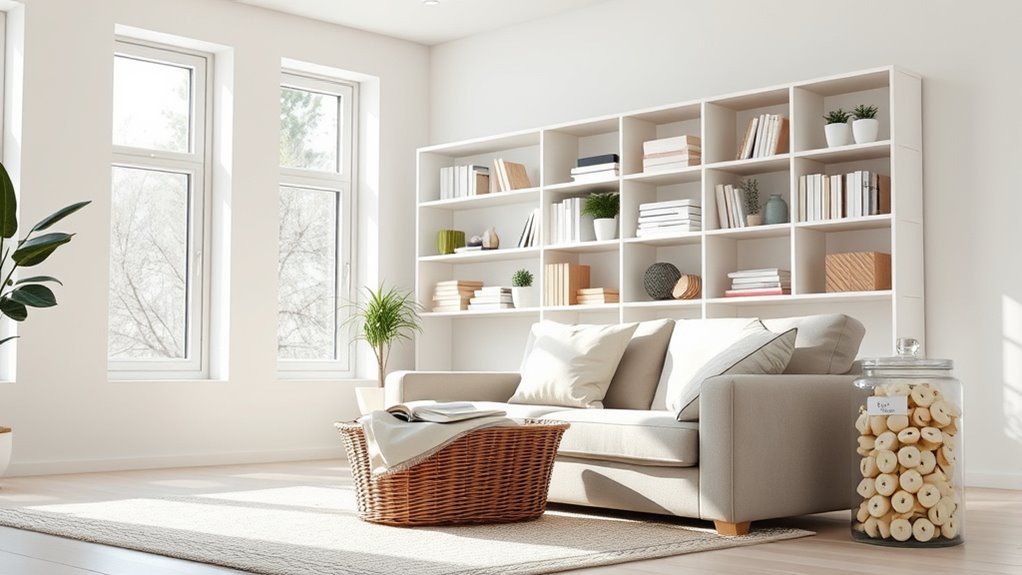
Building long-term habits is essential to maintaining an organized home, especially after decluttering. Habit formation helps you stay consistent, making organization a natural part of your daily routine. To succeed, prioritize effective time management. Dedicate a few minutes each day to tidying up, such as returning items to their designated spots or decluttering a small area. Break tasks into manageable steps, and set reminders if needed. The key is to make organization effortless and habitual, so it becomes second nature. Over time, these habits will reinforce a clutter-free environment, reducing the chances of chaos returning. Remember, consistency is vital—small, daily efforts will lead to lasting change and a more organized, peaceful home.
Frequently Asked Questions
How Do I Stay Motivated During the Decluttering Process?
Staying motivated during decluttering can be tough, but mindset shifts make a big difference. Visualize the benefits, like a cleaner space and less stress, to keep you going. Consider accountability partners who can encourage you and hold you responsible. Break the process into small, manageable tasks, and celebrate each win. With the right mindset and support, you’ll stay motivated and see your home transform faster than you imagined.
What Should I Do With Sentimental Items I Can’t Part With?
When it comes to sentimental items you can’t part with, remember that every keepsake has its own story. To preserve sentimental value, consider creative keepsake preservation methods like photo books or digital scans. If an item holds deep emotional significance, keep a select few and find meaningful ways to display or store them. Don’t let clutter overshadow their importance—cherish memories while keeping your space tidy.
How Often Should I Schedule Decluttering Sessions?
You should schedule decluttering sessions every few months, like quarterly or semi-annually, to keep your space organized. Regular sessions help you maintain effective storage solutions and incorporate decluttering into your cleaning routines. By setting consistent dates, you stay motivated and prevent clutter from accumulating. Adjust the frequency based on your home’s needs and your lifestyle, ensuring your space stays tidy and functional without feeling overwhelming.
How Can I Prevent Clutter From Accumulating Again?
Did you know that the average person spends 55 minutes a day searching for lost items? To prevent clutter from building up again, you should adopt smart storage solutions and develop simple daily habits. Regularly put things back in their designated spots, avoid hoarding, and reassess your storage needs periodically. These small changes make a big difference in maintaining an organized space effortlessly.
What Are Quick Tips for Decluttering Small Spaces Effectively?
To declutter small spaces effectively, start with simple organizing hacks like maximizing vertical storage and using multi-purpose furniture. Use storage solutions such as wall-mounted shelves or under-bed containers to free up surface areas. Regularly assess items and remove anything unnecessary. Keep things tidy by establishing routines, like putting things back immediately after use. These quick tips help maintain order and make small spaces feel more open and functional.
Conclusion
Remember, decluttering is like tending a garden—consistent care yields beauty and harmony. By taking small steps, staying focused, and celebrating your progress, you’ll transform your space into a sanctuary. Keep in mind that even Hercules faced challenges, but perseverance turned chaos into clarity. With each session, you’re forging a more organized home—and a clearer mind. Stay committed, and you’ll find that the journey is just as rewarding as the destination.
